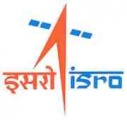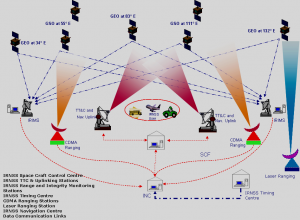If you wish to contribute or participate in the discussions about articles you are invited to contact the Editor
NAVIC
| IRNSS | |
|---|---|
| Title | NAVIC |
| Author(s) | GMV |
| Level | Basic |
| Year of Publication | 2011 |
The Indian Regional Navigational Satellite System (IRNSS) is a regional satellite navigation system owned by the Indian government. The system is being developed by Indian Space Research Organization (ISRO) .
IRNSS Introduction
IRNSS will be an independent and autonomous regional navigation system aiming a service area of about 1500 kilometers around India. The system will be under complete Indian control, with the space segment, ground segment and user receivers all being built in India.[1] It will have a range of applications including personal navigation.
IRNSS Architecture
IRNSS is planned to have 7 satellites complemented with the appropriate ground infrastructure.[2] As it is traditional in GNSS systems, the architecture is described next in three different segments: the space segment, the ground segment and the user segment.
- The IRNSS Space Segment: 3 of the 7 satellites are geostationary orbit (GEOs) and they will be located at 34º East, 83º East and 131.5º East longitude.[3] There will be 4 geostationary satellites (GSO) in orbits of 24,000 km apogee and 250 km perigee inclined at 29 degrees. Two of the GSOs will cross the equator at 55º East and two at 111º East. The life span of the GEOs is 9.5 years and 11 years in the case of the GSOs.[2] The Constellation Design Considerations have been mainly:[3]
- Minimizing the Maximum DOP
- Minimum number of satellites
- Orbital slots for India for a continuous visibility with the control stations
- The IRNSS Ground Segment will consist of:[3]
- IRNSS Space Craft Control Centre (SCC)
- IRNSS Navigation Centre (INC)
- IRNSS TTC & Uplinking Stations (IRTTC)
- IRNSS Range and Integrity Monitoring Stations (IRIMS)
- IRNSS Timing Centre (IRNWT)
- CDMA Ranging Stations (IRCDR)
- Laser Ranging Station (ILRS)
- Data Communication Network (IRDCN)
The SCC and the INC will be the core of the ground segment, and they are in charge of estimating and predicting IRNSS satellites position, calculation of integrity, ionospheric and clock corrections and running the navigation software.
- The IRNSS User segment: the IRNSS user segment is made of the IRNSS receivers. They will be dual-frequency receivers or single frequency with capability to receive ionospheric correction. They will be able to receive and process navigation data from other GNSS constellations and the seven IRNSS satellites will be continuously tracked by the user receiver. The user receiver will have a minimum gain G/T of -27 dB/K.[3]
IRNSS Services and Performances
There will be two kinds of services:[2]
- Special Positioning Service (SPS): The IRNSS signal of this service will be modulated by a 1 MHz BPSK signal.
- Precision Service (PS): this service will use BOC(5,2).
Both services will be carried on L5 (1176.45 MHz) and S band (2492.08 MHz). The navigation signals would be transmitted in the S-band frequency (2–4 GHz) and broadcast through a phased array antenna to keep required coverage and signal strength.
The data structure for SPS and PS is under study; it is being planned to take advantage of the fact that the number of satellites is reduced -7 instead of the 30 used in other constellations- to broadcast ionospheric corrections for a grid of 80 points to provide service to single frequency users. The clock, ephemeris, almanac data of the 7 IRNSS satellites will be transmitted with the same accuracy as in legacy GPS, GLONASS & Galileo.[4]
The Performances expected for the IRNSS system are: Position accuracy around 20 m over the Indian Ocean Region (1500 km around India) and less than 10 m accuracy over India and GSO adjacent countries.
IRNSS Development
The Indian government approved the project in May 2006, with the intention of the system to be completed and implemented by 2014. The first satellite of the proposed constellation is expected to be launched by end 2011. The news that came in April 2010 stated that India plans to launch the first satellite by end of 2011 and the rest with six months periodic launches. This means that the IRNSS system would be functional by 2014.[1][5]
Notes
References
- ^ a b IRNSS in Wikipedia
- ^ a b c IRNSS and GAGAN status Presentation COSPAR Meeting, Montreal, July 2008
- ^ a b c d IRNSS and GAGAN Status Presentation Second Meeting of the ICG Providers Forum, Vienna, Austria, February 2008
- ^ GAGAN and IRNSS Status Presentation ICG-3 Meeting, Pasadena, United States of America, December 2008
- ^ Launch of first satellite for Indian Regional Navigation Satellite system next year The Hindu news, April 2010



